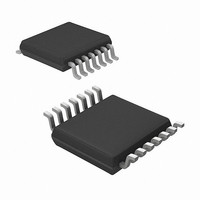MRF49XA-I/ST Microchip Technology, MRF49XA-I/ST Datasheet - Page 15

MRF49XA-I/ST
Manufacturer Part Number
MRF49XA-I/ST
Description
IC RF TXRX 433/868/915 16-TSSOP
Manufacturer
Microchip Technology
Datasheet
1.MRF49XA-IST.pdf
(102 pages)
Specifications of MRF49XA-I/ST
Package / Case
16-TSSOP
Frequency
433MHz, 868MHz, 915MHz
Data Rate - Maximum
256kbps
Modulation Or Protocol
FHSS, FSK
Applications
Home / Industrial Automation, Remote Access, Security Alarms
Power - Output
7dbm
Sensitivity
-110dBm
Voltage - Supply
2.2 V ~ 3.8 V
Current - Receiving
11mA
Current - Transmitting
15mA
Data Interface
PCB, Surface Mount
Antenna Connector
PCB, Surface Mount
Operating Temperature
-40°C ~ 85°C
Number Of Receivers
1
Number Of Transmitters
2
Wireless Frequency
433 MHz to 915 MHz
Output Power
+ 7 dBm
Operating Supply Voltage
2.5 V, 3.3 V
Maximum Operating Temperature
+ 85 C
Mounting Style
SMD/SMT
Minimum Operating Temperature
- 40 C
Modulation
FHSS, FSK
Lead Free Status / RoHS Status
Lead free / RoHS Compliant
Memory Size
-
Lead Free Status / Rohs Status
Lead free / RoHS Compliant
Other names
579-MRF49XA-1/ST
Available stocks
Company
Part Number
Manufacturer
Quantity
Price
Company:
Part Number:
MRF49XA-I/ST
Manufacturer:
IR
Quantity:
450
Part Number:
MRF49XA-I/ST
Manufacturer:
MICROCHIP/微芯
Quantity:
20 000
2.10
2.10.1
The MRF49XA provides the RSSI signal to the host
microcontroller, and hence, supports the monitoring of
analog and digital signal strengths. A digital RSSI output
is provided to monitor the input signal level through an
internal STATUS register. The digital RSSI goes high, if
the received signal strength exceeds a given prepro-
grammed RSSI threshold level. The digital RSSI can be
monitored by reading the STSREG. Alternatively, an
analog RSSI signal is also available at pin 15 (RSSIO) to
determine the signal strength. The analog RSSI settling
time depends on the external filter capacitor. Typically, a
4-10 nF capacitor provides optimum response time for
most of the applications. See Section 4.0 “Application
Details” and Section 5.0 “Electrical Characteristics”
for details on filter capacitors for analog RSSI. The
typical relationship between analog RSSI voltage and
RF input power is graphically represented in Figure 2-2.
FIGURE 2-2:
•
© 2009 Microchip Technology Inc.
Data Validity Blocks
RECEIVE SIGNAL STRENGTH
INDICATOR
ANALOG RSSI VOLTAGE
1150
450
-100
Input Power (dBm)
Preliminary
VS
. RF INPUT POWER
2.10.2
The Data Quality Indicator (DQI) is a special function
which indicates the quality of the received signal and
the link. The unfiltered received data is sampled and
the number of spikes are counted in the received data
for a specified time. If the input signals are of high
value, it indicates the operating FSK transmitter of the
high output signal within the baseband filter bandwidth
from the local oscillator.
2.10.3
The Data Indicator Output (DIO) is an extension of DQI.
The DIO pin can be configured to indicate valid data
based on the actual internal settings. When an incom-
ing signal is detected, the DIO uses the DQI clock
recovery lock and digital RSSI signals to determine the
validity of the incoming signal. The DIO searches for
the valid data transitions at an expected data rate. The
desired data rate and the acceptance criteria for valid
data are user-programmable through the SPI port. The
DIO signal is valid when using the internal receive FIFO
or an external pin to capture baseband data.
The DIO has three modes of operation: Slow, Medium
and Fast. Each mode is dependent on the type of sig-
nals it uses to determine the valid data and the number
of incoming preamble bits present at the beginning of
the packet. The DIO can be multiplexed with the INT
pin for external usage.
-65
DATA QUALITY INDICATOR
DATA INDICATOR OUTPUT
MRF49XA
DS70590B-page 13












